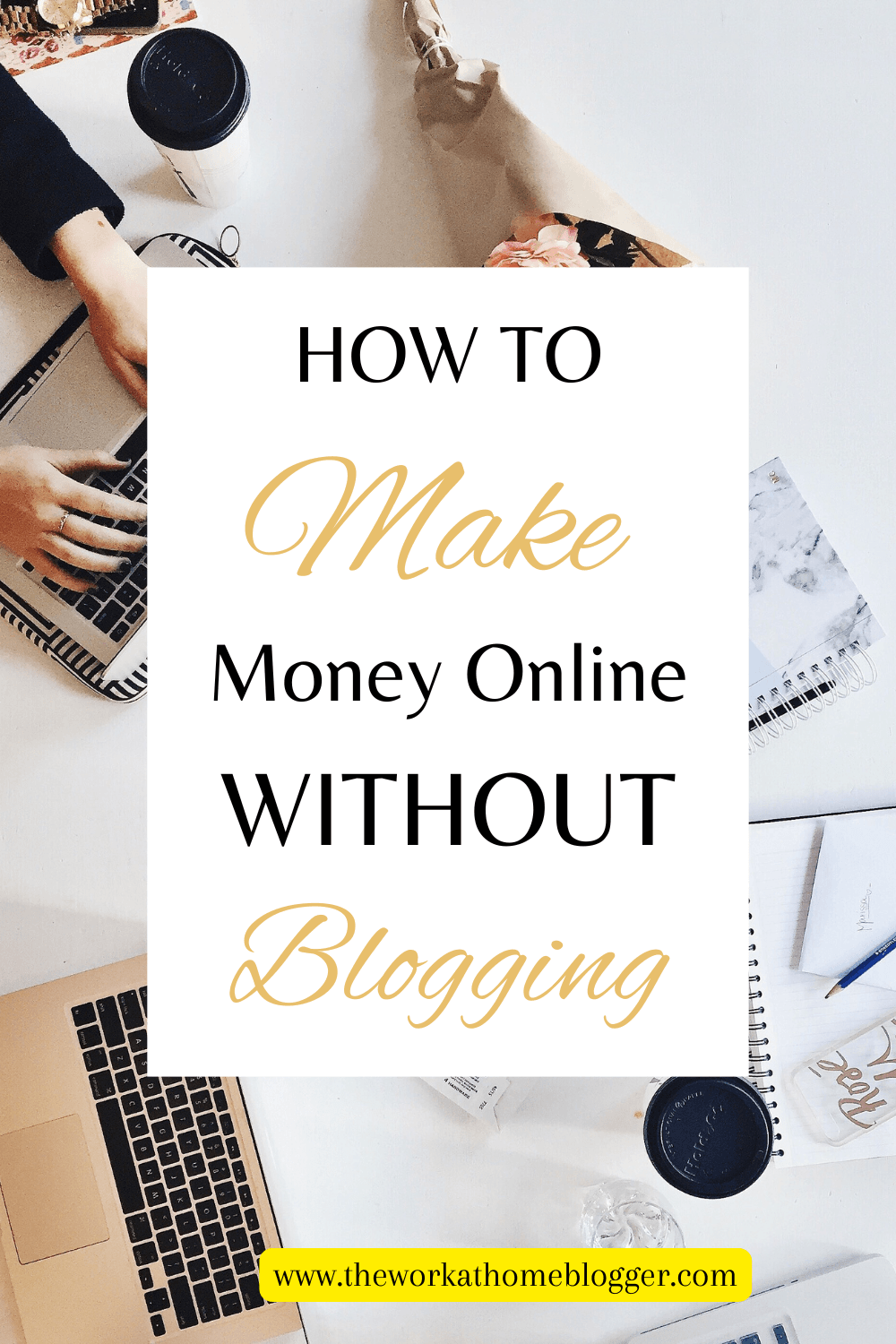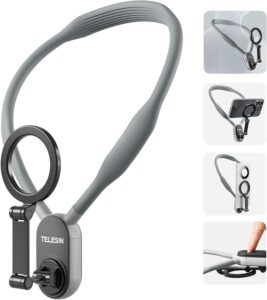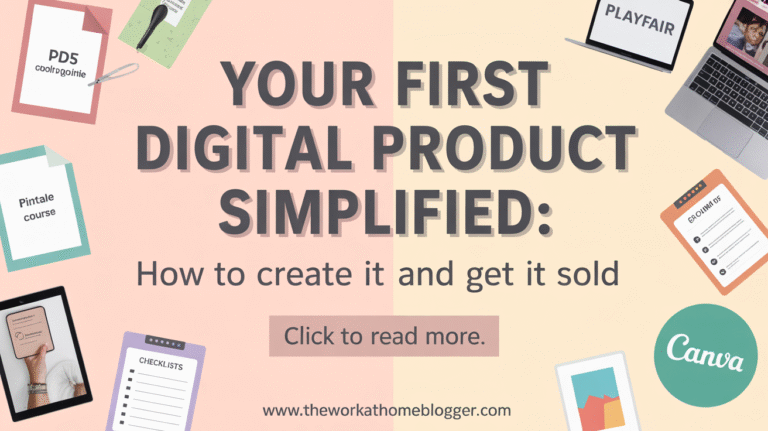
If you want to know how to make money online without blogging, you came to the right place. Blogging is my passion and it’s what I do for a living. However, not everyone thinks the same about blogging. Some are not interested in blogging but are interested in learning how to make money online.
If you’re interested in other ways to make money online without blogging, then please keep reading to find out more.
There are so many ways to make money online without blogging and the best part is that you don’t need any money to start. There are a few things you will need to get started. Those are expertise, monetizable skills, and online presence.
You also will need a laptop if you don’t have any.
I have been a blogger since 2018 and I understand the concept of blogging. However, not everyone is keen to start a blog because is not in their interest. And that is okay.
However, don’t let this stop you from making money online, because blogging is not the only way to make money online. Especially if you’re interested in affiliate marketing as a way to make monthly income.
When people think of passive income with affiliate marketing without a website, automatically think of YouTube. Well, yes, YouTube is a way but there are more ways to do this.
*Disclosure: This post may contain affiliate links at no additional cost to you. I only recommend products I would use myself; all opinions expressed here are mine. In addition, I may earn a small commission.
How to Make Money Without Blogging?
Blogging can be a lucrative business. However, not everyone is keen on blogging. Some prefer other means to make money online without blogging, which I will mention later in this blog post.
If you want to make money without blogging, you have to first find a profitable niche that aligns with your expertise, interests, and experience. Secondly, you have to find the right platform of your choice that aligns with your business goals.
What Are The Ways to Make Money Online Without Blogging?
There are multiple ways to make money online and here I will give you a list of what you can do to find a profitable way to make money online without the need to blog.
- Start a Freelance Side Hustle
- Sell Online (e-commerce, print-on-demand, dropshipping, etc.)
- Apply for remote jobs.
- Start a YouTube, TikTok, or Instagram account and have a link-in bio
- Start a Coaching Services
- Affiliate Marketing. Apply to join affiliate programs and promote your links on a link-in bio or start an affiliate links storefront such as Amazon, Collective Voice, or Wayward.
- Start a Podcast.
- Grow your LinkedIn profile and expand your reach. This is to help your business grow. Be active and share your knowledge.
- Start a Patreon Page. Or create a membership site.
- Learn how to flip websites.
Start a Freelance Side Hustle
If you have a 9-5 job but want to start a side hustle and blogging is not your thing, freelancing is a great side hustle. If you have monetizable skills and expertise, you can definitely start freelancing.
Ready, set, publish—create your website in a flash with Hostinger AI Website Builder. Tell us what you need, and our AI will do the rest. 30-Day Refund Policy. Fast and Easy Setup. Trusted Worldwide. Intuitive website builder.
What You Need to Start
You will need a couple of things before you start your freelancing business.
You will need:
- website and hosting
- domain
- legal templates- At least 3: Terms and Conditions, Disclaimer, and Privacy Policy.
- business social media accounts.
- A Fiverr or Upwork account or on any other freelancing site.
You can create a free website using sites such as Google Sites, Beacons.AI, Systeme.io, or Podia to have a digital presence. These free sites already come with hosting. There is no need to purchase any additional hosting.
Purchase a domain on sites such as Namecheap or Domains and then add it to your website.
You will also need legal templates for your site because it will be running as a business. So, make sure to have it on your site.
You need at least 3 legal templates, which can be purchased as a bundle. These are the Terms and Conditions, Disclaimer, and Privacy Policy.
No need for expensive hosting or a website when you’re just starting out. Creating a website on Google Sites or Podia is very easy. You can use Beacons.AI, a free website builder, too.
In addition to your website, you can also create your freelancing profile on sites like Fiverr or Upwork. Optimize your LinkedIn profile to showcase your freelancing skills and services to other businesses that are looking for freelancers.
Sell Online
If freelancing is not your thing, you have the option to sell products online whether digital or physical. And, no you don’t have to sell on Shopify or Amazon to get started. You can if you have the means but you don’t have to. You can start on Shopify for only $1 for a 1-month trial.
There are great websites you can try for free.
You will need a domain and legal templates for your site. See below for the free websites where to sell for free.
Again, you will need it because it will be a business and not a hobby.
Here are the best free websites you can try for free and sell your products:
Sidenote: For print-on-demand, 100% free means no cost and no fulfillment fees at your end. You will be responsible for reporting your sales and taxes.
- Printify Pop-Up-Print-on-demand 100% free-No need for a domain. You will get a subdomain. No need for legal templates.
- Big Cartel-In the free account, you’re allowed up to 5 products with one image per product. Limited features.
- Ecwid-Physical products only. Unlimited images. Up to 5 products on the free account. For digital products, you will need a paid plan. You can embed your store to a free Google Site.
- Podia-Free website and blog. You can sell digital products. Limited features.
- PayHip-Unlimited products and unlimited features on the free account. High transaction fees on the free account. If you want no transaction fees, you will need the highest-paid plan.
- Beacons.AI- Free store for physical and digital products. Limited features. It integrates with some e-commerce platforms such as Shopify, Etsy, Gumroad, PayHip, etc.
- Gumroad- You can sell physical and digital products. High transaction fees.
- Amazon Merch-Print on demand 100% free- No need for a domain, or legal templates, and you get paid once per month based on any royalties earned.
- RedBubble-Print-on-demand 100% free-Similar to Amazon Merch. You earned based on a percentage of each sale.
- TeePublic-Print-on-demand 100% free
Apply for Remote Jobs
If you don’t want the responsibility of starting and running a business then you can consider applying for remote jobs. There are legit job sites where you can apply for remote jobs.
Having a remote job gives you the flexibility of working from home or anywhere if the employer allows you to. You will also get all the benefits such as medical, vision, PTO, vacation pay, and much more.
You can apply for jobs directly on the company site and search for “remote jobs”. Or go to FlexJobs or Remote.Co and look for remote jobs there.
For FlexJobs, you will need to pay for a membership plan.
These memberships allow for the FlexJobs staff team to screen each job to confirm its legitimacy. This is to prevent members from getting scammed.
You can also try Indeed, LinkedIn jobs, Glassdoor, etc.
Start a YouTube, TikTok, or Instagram Business/Creator Profile
To make money online without blogging another option you have is to start a YouTube channel or create a business or creator profile on TikTok or Instagram. When you start creating videos, you can apply for affiliate programs. I suggest to apply for companies or programs you’re familiar with.
On these platforms, you can add a link-in bio such as Beacons.AI (which is free), and add your media kit, affiliate links, store, website, etc.
On YouTube, you can promote affiliate links by adding them to the description box of each video. Just make sure to add a disclaimer on each video you publish. It’s required by law FTC to do this.
If you don’t want to show your face, you can do this by using stock videos and voice-overs either AI or your voice.
What you need:
- A camera, a tripod, and a microphone. If you want to create faceless videos then you can have it point to your hands instead of your face. This works great when doing product review videos or creating UGC (User Generated Content). You can use products like this:

TELESIN° Magnetic Neck Mount for Phones
TELESIN° world premiere magnetic cellphone neck mount set includes 1 x Magnetic Neck Mount, 1 x Magnetic Piece (Used for smartphones without magnetism ), 1 x Cleaning Kit (Used for wiping the phone case of a cell phone without magnetism before attaching the magnetic piece to the case ), 1 x Anti-Lost Rope, 1 x Specification. (Affiliate link)
Another option will be to use software such as Doodly, FlexClip, or Canva to create faceless videos. With the software, you will have to add royalty-free stock videos and photos for your faceless videos and voiceover audio. You can use AI tools for voiceovers or record your voice and add it to the video. If neither applies for the voiceover option then you can add a background copyright-free music and royalty-free music. You can find free background music on YouTube Audio library, or use sites such as Pixabay.
You can also purchase licenses for background music and any other digital assets on Envato Market for a low-priced monthly subscription.
Start a Coaching Business
A coaching business is perfect if you have the skills, knowledge, and love of helping people improve their lives. You can start a coaching business in the niche or industry you’re experienced in and are passionate about. For example, you can be a career coach, relationship coach, personal development coach, etc.
Things you will need to start:
- A website
- Certifications and credentials
- A marketing strategy
- Build your personal brand
- Target your specific audience
To learn about how to start a coaching business you can read these articles for more information:
Affiliate Marketing
I started affiliate marketing when I started blogging officially back in 2018. And, officially mean, when I bought a domain, got hosting, and a WordPress website. However, I didn’t make a single sale with affiliate marketing. I didn’t understand the concept behind affiliate marketing because everything was still new to me. I didn’t know how to do keyword research, write blogging content, and how to build a marketing plan.
I made my first $50 during that time through a sponsored post. Then afterward, because I didn’t make any money I moved my writing to Medium platform. Then Covid happened. I got an unemployment check and used that check to purchase a course to learn how to monetize my blog.
The course helped me make affiliate sales within a few months. I made my first affiliate sale two months after I implemented everything I was learning from the course. I was on Module 1 when I started implementing what I was learning and it worked. So, the course worked fast.
So, my point is that if you start right then you will see results. In the beginning, when I started in 2018, I didn’t make any affiliate sales because I didn’t know any better. 3 years later after I took the risk to invest in myself and my business and implemented what I learned, I finally saw results.
To get started in affiliate marketing, you will need:
- A platform of choice-Beacons.AI, Podia, YouTube, etc.
- Depending on the platform, if applicable, you will need a domain and legal templates. Otherwise, skip this step.
- Join programs such as Impact, PartnerStack, Share-a-Sale, etc. Or you can try to join affiliate storefronts such as Wayward, Collective Voice, or Amazon Storefront.
- Use link-in bio apps such as Beacons.AI to promote your links on social media accounts. Free to use. You will get a free website, a free domain for up to one year, and free email marketing for up to 500 subscribers.
Start a Podcast
Starting a podcast is a rewarding way to share your knowledge, engage with an audience, and establish your authority in a specific niche. The process begins with conceptualizing your podcast, which involves selecting a topic you’re passionate about and defining your target audience. Planning your episodes, including their structure and content, is crucial for consistency and quality.
You’ll need basic equipment such as a good-quality microphone, headphones, and recording software like Audacity or Adobe Audition. Setting up a quiet recording space with some soundproofing helps ensure clear audio. Recording your episodes involves preparing scripts or outlines, doing test recordings, and speaking clearly and consistently.
Editing is an essential step where you remove background noise, adjust audio levels, and add music or effects to enhance the listening experience. After editing, you need a podcast hosting platform like Libsyn, Podbean, or Anchor to store your audio files and distribute them to directories such as Apple Podcasts, Spotify, and Google Podcasts.
Promotion is key to growing your podcast. Share episodes on social media, create a website or blog for additional content, and network with other podcasters. Engaging with your audience through feedback and interaction helps build a loyal community.
Starting a podcast offers numerous benefits, including building credibility, expanding your reach, and providing a creative outlet. It also opens up opportunities for monetization through sponsorships, merchandise, and crowdfunding. With a minimal initial investment and the potential for significant rewards, starting a podcast can be a fulfilling and impactful venture.
Reasons to Start a Podcast
1. Build Authority in Your Niche
- Establish Expertise: Sharing your knowledge and insights on specific topics can position you as an authority in your field.
- Credibility: Consistently delivering valuable content can build your reputation and credibility, attracting a loyal audience.
2. Engage with Your Audience
- Personal Connection: Podcasts offer a more intimate and personal way to connect with your audience compared to written content.
- Interactive Platform: You can engage with listeners through Q&A sessions, interviews, and listener feedback, fostering a sense of community.
3. Expand Your Reach
- Global Audience: Podcasts are accessible worldwide, allowing you to reach a diverse and extensive audience.
- Platform Diversity: By distributing your podcast on multiple platforms (Apple Podcasts, Spotify, Google Podcasts), you can increase your visibility and attract new listeners.
4. Enhance Your Brand
- Brand Personality: A podcast allows you to showcase your brand’s personality and values, creating a deeper connection with your audience.
- Content Variety: It diversifies your content portfolio, complementing blogs, videos, and social media posts, thereby strengthening your overall brand presence.
5. Networking Opportunities
- Guest Interviews: Inviting industry experts, influencers, and thought leaders to your podcast can open doors for collaboration and networking.
- Community Building: Engaging with other podcasters and participating in podcasting events can expand your professional network.
6. Monetization Potential
- Sponsorships: As your podcast grows, you can attract sponsors and earn revenue through advertisements.
- Premium Content: Offer exclusive content or bonus episodes through subscription models or platforms like Patreon.
- Product Promotion: Promote your own products or services, driving traffic and sales through your podcast.
7. Low Entry Barrier
- Affordable Setup: Starting a podcast requires minimal initial investment. Basic equipment and free software can get you started.
- Ease of Production: With practice, recording and editing podcasts can become a straightforward process, allowing you to produce content regularly.
8. Creative Outlet
- Express Yourself: A podcast provides a platform to share your thoughts, stories, and creative ideas.
- Experimentation: You can experiment with different formats, styles, and topics, keeping your content fresh and engaging.
9. Educational Value
- Learning Opportunity: Researching topics and preparing content can deepen your knowledge and understanding of your niche.
- Audience Education: You can educate and inspire your audience, providing valuable insights and actionable advice.
Starting a podcast offers numerous benefits, from building authority and engaging with your audience to expanding your reach and monetizing your efforts. It’s a versatile and impactful way to enhance your personal brand, create valuable connections, and share your passion with a global audience.
Quick Tutorial on How to Start a Podcast
1. Conceptualize Your Podcast
- Choose a Topic: Select a niche you are passionate about and knowledgeable in. It should be broad enough to cover various subtopics but focused on attracting a dedicated audience.
- Define Your Audience: Identify your target audience. Understand their interests, challenges, and preferences to tailor your content accordingly.
- Format and Style: Decide the format of your podcast (interview, solo, panel, storytelling) and the tone (informal, educational, humorous).
2. Plan Your Episodes
- Content Outline: Create a content calendar with episode topics, guest appearances, and key points to discuss.
- Episode Structure: Plan the structure of each episode (introduction, main content, segments, conclusion). Consistency helps retain listeners.
3. Gather Equipment
- Microphone: Invest in a good quality microphone. Popular choices include the Blue Yeti or Audio-Technica ATR2100.
- Headphones: Use closed-back headphones to monitor audio quality.
- Recording Software: Use free software like Audacity or paid options like Adobe Audition for recording and editing.
4. Set Up Recording Space
- Quiet Environment: Choose a quiet location with minimal background noise.
- Soundproofing: Use foam panels or soft furnishings to reduce echo and improve sound quality.
5. Record Your Episode
- Script and Outline: Prepare a script or outline to stay on track during recording.
- Test Recording: Do a test recording to check audio levels and clarity.
- Record: Use your chosen software to record the episode. Speak clearly and maintain a consistent distance from the microphone.
6. Edit Your Podcast
- Editing Software: Use your recording software to edit the audio. Remove background noise, adjust levels, and trim unnecessary parts.
- Add Music and Effects: Incorporate intro and outro music, sound effects, and transitions to enhance the listening experience.
7. Publish Your Podcast
- Podcast Hosting: Choose a podcast hosting platform like Libsyn, Podbean, or Anchor. These services store your audio files and distribute your podcast to directories.
- RSS Feed: The hosting platform will generate an RSS feed for your podcast. This feed is used to distribute your episodes to platforms like Apple Podcasts, Spotify, and Google Podcasts.
8. Promote Your Podcast
- Social Media: Share episodes on social media platforms like Twitter, Facebook, and Instagram. Engage with your audience through comments and messages.
- Website and Blog: Create a website or blog to host show notes, episode transcripts, and additional content.
- Networking: Collaborate with other podcasters, participate in podcasting communities, and attend related events to grow your network and audience.
9. Engage with Your Audience
- Feedback: Encourage listeners to leave reviews and feedback. Use this input to improve your content.
- Listener Interaction: Respond to listener questions and comments. Consider incorporating listener suggestions into future episodes.
10. Monetize Your Podcast (Optional)
- Sponsorships: Partner with brands for sponsorship opportunities.
- Merchandise: Sell branded merchandise to your audience.
- Crowdfunding: Use platforms like Patreon to receive direct support from your listeners.
Starting a podcast involves careful planning, investing in the right equipment, and consistent effort in creating and promoting your content. With dedication and creativity, you can build a successful podcast that engages and grows your audience.
Utilize LinkedIn for Professional Services
LinkedIn isn’t just a networking platform; it’s a powerful tool to market your skills and connect with potential clients or employers. If you’re a beginner, here’s a step-by-step guide to make LinkedIn work for you:
- Create a Polished Profile: Start by building a professional-looking LinkedIn profile. Use a clear, high-quality headshot and write a headline that highlights your skills or services (e.g., “Freelance Content Writer | SEO Expert”). Your summary should include a brief overview of your experience, skills, and the services you’re offering. Add relevant certifications or courses you’ve completed to build credibility.
- Showcase Your Work: Use the “Featured” section to display your portfolio, case studies, or testimonials. If you’re just starting, you can include volunteer work, personal projects, or samples that demonstrate your expertise.
- Engage with Your Network: Post regular updates sharing insights about your field, personal achievements, or useful tips. For example, if you’re a graphic designer, you could share a post about design trends or a project you’ve recently completed. Comment on other posts to build relationships and increase visibility.
- Search for Opportunities: Use the job search feature to find freelance gigs or remote work. Join LinkedIn groups relevant to your industry, as these often have job postings or collaboration opportunities.
- Pitch Yourself: Reach out directly to companies or individuals who might need your services. Personalize your messages to explain how you can solve their problems. For example, instead of saying, “I’m a social media manager,” you might say, “I can help increase your brand’s Instagram engagement by 30% within three months.”
LinkedIn is an excellent starting point for beginners, as it’s free and allows you to connect with decision-makers in various industries.
Flip Websites or Domains
Website and domain flipping is a beginner-friendly way to make money online, especially if you have an interest in digital marketing or basic web design. Here’s how you can get started:
- Understanding the Basics: Website flipping involves buying an existing website, improving it, and selling it for a profit. Domain flipping focuses solely on buying and selling domain names.
- Finding Websites or Domains to Flip: Platforms like Flippa and Empire Flippers are great for beginners. Browse these marketplaces to identify undervalued websites or domain names. Look for websites with decent traffic but poor design or minimal monetization, as they have high potential for improvement. For domain flipping, search for short, memorable domain names or those containing trending keywords.
- Improving the Website: Once you purchase a website, focus on increasing its value. This might include:
- Enhancing Content: Add high-quality, SEO-optimized content to attract more visitors.
- Optimizing Design: Improve the website’s appearance and navigation to create a better user experience.
- Adding Monetization: Introduce ads, affiliate links, or products to generate revenue.
- Boosting Traffic: Use social media, email marketing, or paid ads to drive more visitors.
- Selling Your Website: Once the website shows improved performance, list it on platforms like Flippa with clear data on its traffic, revenue, and improvements. Write an appealing description to attract buyers.
Domain flipping requires less work but relies on picking the right names. You can resell these domains on platforms like Sedo or GoDaddy Auctions.
Create a Patreon Page
Patreon is perfect for creators who want to monetize their work directly through fan support. Even beginners can set up a successful Patreon page by following these steps:
- Define Your Niche: Identify what value you can provide to your audience. Are you an artist, writer, musician, or fitness coach? Determine what makes your work unique and worth supporting.
- Set Up Your Page: Create a Patreon account and customize your page. Write a compelling bio explaining who you are, what you create, and why people should support you. Use visuals like banners or videos to make your page more appealing.
- Offer Exclusive Rewards: Patrons are more likely to subscribe if they receive exclusive perks. Here are some ideas:
- Behind-the-Scenes Content: Share how you create your work, your daily process, or sneak peeks of upcoming projects.
- Exclusive Downloads: Provide eBooks, templates, music tracks, or digital art.
- Live Interactions: Host Q&A sessions, live streams, or virtual hangouts for your patrons.
- Shoutouts: Acknowledge your supporters in your work or social media posts.
- Create Membership Tiers: Offer different levels of support with increasing rewards. For instance, a $5 tier could grant access to exclusive posts, while a $20 tier includes one-on-one coaching or personalized content.
- Promote Your Patreon: Use your social media platforms, email list, or existing audience to drive traffic to your Patreon page. Be consistent in reminding your followers about the benefits of becoming a patron.
Patreon allows you to create a sustainable income by focusing on quality and consistency. Engage with your supporters regularly to build loyalty and encourage them to stay subscribed.
FAQ
1. Can I use LinkedIn if I don’t have professional experience? Absolutely! Highlight transferable skills, volunteer projects, and certifications. Many people start with personal projects or internships to build their profiles.
2. How much money can I make flipping websites or domains? This varies greatly. Beginners might earn a few hundred dollars per flip, while experienced flippers can make thousands. Start small and scale as you learn.
3. Do I need a large audience to succeed on Patreon? No. Even a small, engaged audience can generate a steady income. Focus on creating high-quality content and building strong relationships with your supporters.
Conclusion
Making money online without blogging is entirely possible, and the opportunities are vast.
Whether you’re leveraging LinkedIn to land clients, flipping websites for a profit, or using Patreon to monetize your creative work, the key is to start small and stay consistent.
Experiment with these strategies, find what works best for you, and keep learning as you go.
Success won’t happen overnight, but with dedication, you’ll be well on your way to achieving your online income goals.








